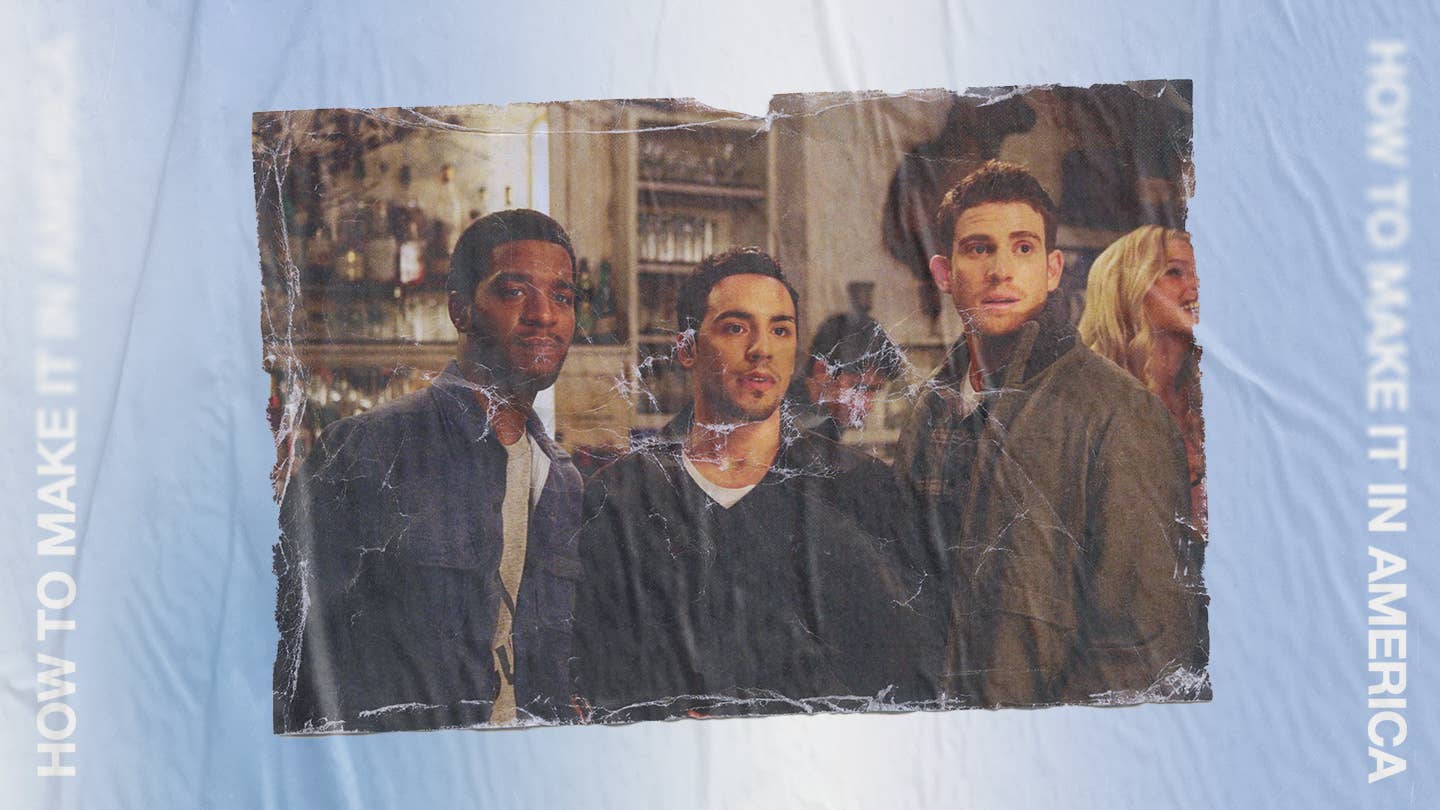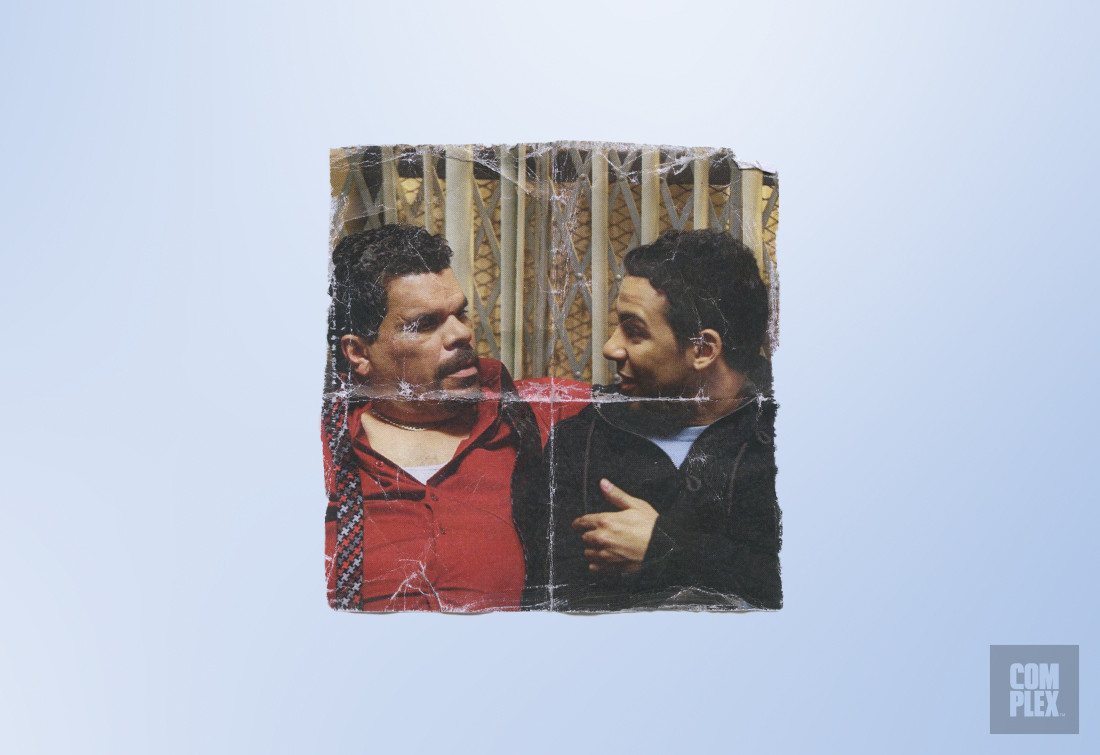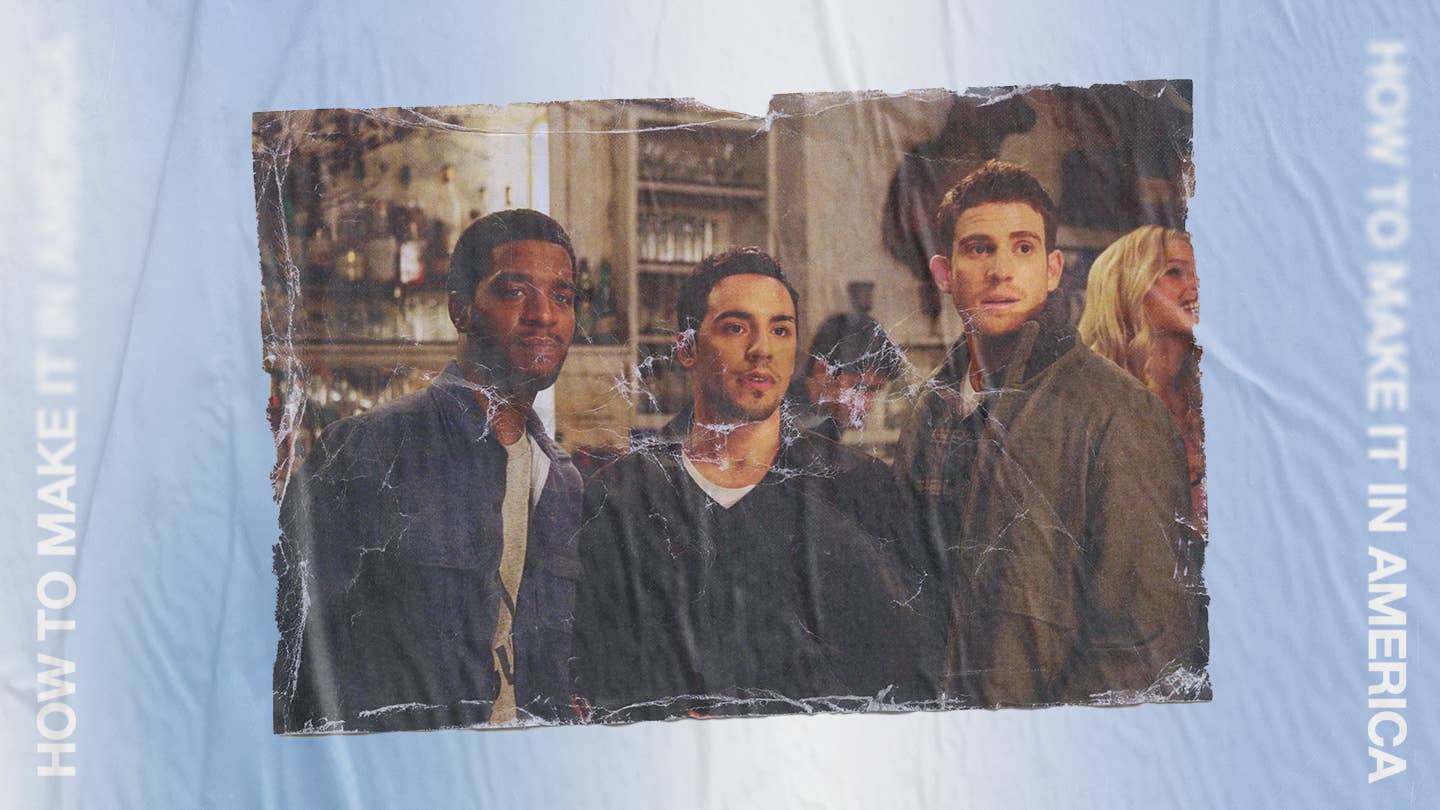
How to Make It in America's second season was new territory thanks, in large part, to an influx of HBO money. The result? A quicker pace, more structure, and better character development as the show's training wheels were removed. Season 1 felt like an experiment at times—especially during the earlier episodes. Season 2 took a noticeable step forward as the show appeared to be finding itself.
Season 2
Farino: [In Season 2], HBO asked for more narrative of [the characters] progressing. For me, I would’ve been happy to do the show with them scraping around for $200 every week. I loved the ground-level element of Season 1. I really did. But HBO was asking us to create a little more in terms of upward trajectory for them. So it became a bit less loose in slack.
Edelman: In the second season, we had this new producer, Jill Soloway. Jill created that show Transparent. Jill came into the show like, “I’m a Lake fan. Let’s do more with Lake.” And I was like, “Let’s do it.”
Bell: Jill Soloway was the co-showrunner for Season 2 and wrote so many beautiful, hilarious moments for Rachel, and I’m just indebted for that. I feel like I have Jill to thank for a lot of the great Rachel story threads, and Jill also had a huge part in writing the episode where I get a tattoo from a famous tattoo artist, Scott Campbell, who ended up being my husband. So when I [see Jill], Jill’s like, “You’re welcome.”
Farino: In terms of making sure it was balanced, because it was mostly blokes making [the show], Jill came in to challenge us with a woman’s perspective. I remember just hanging around and chit-chatting; it didn’t go that deep. And then, the next minute, Jill had one of the best shows in America.
Greenberg: Jill’s energy changed the show. It got a little more interesting and a little weirder, which I liked. And I think we sort of figured out our tone and what the show was.
Rasuk: I think they just focused a lot more on what Ben and Cam really wanted. With Cam, he wanted his own crib. That’s why I love the whole scene when he’s pushing the stove down Bowery [Street] and he’s got his own crib. I think they humanized the characters.
Levieva: I remember when we were shooting [Ben and Julie’s] breakup on the subway. Bryan and I really enjoyed that because so much of the show lived in this fun, light atmosphere, so it was one of the few scenes where it was very dramatic and grounded in something different. We had invested so much time in these characters and had built this love story, so the breakup actually felt really dramatic even though, on the page, it wasn’t crazy. It was sad.
Cudi: This season, my character has a lot more depth than [in] the first season. One of the things I took seriously was preparing. I got an acting coach. I wanted to step it up. I studied the first season. I studied my performance. I knew I was gonna get a lot more this season. I wanted to deliver. I wanted to make the people at HBO happy. I wanted to make my management happy. I wanted to be able to step on the camera with cats like Victor and Bryan Greenberg, who are pros at this shit, guys that have been doing this for years, and be able to do a scene with those guys and maintain and really deliver. [via MTV]
Nunez: In Season 2, they added my character into it more, which was cool. One of the best scenes was probably when I burned down the [Rasta Monsta] ramp. We got to be creative in doing that. We got to film it on the Lower East Side, and a lot of my friends were in the neighborhood, so it was a cool vibe.
Bell: There was this one scene, I’ll never forget it: I’m high on something and I go into a bodega to get some soup, but I start ladling and eating out of the big soup bodega barrel. It was such a simple scene. We shot it at night in a real bodega in the Lower East Side, and it was one of the more fun scenes I’ve ever been a part of in my life. I’ve always had the fantasy of fuckin’ scooping soup out of a bodega barrel, completely high off my rocker.
Greenberg: Getting high and going through the subway was cool because we had to take a training course. You can’t just shoot in the subway on the tracks. You have to do an eight-hour course with [the] MTA and learn all this stuff, so that was fun. Just the inner workings of New York City.
Farino: We all did that class. It was a full day and we ended up being led underground. I think it was because we wanted to shoot on the tracks, as well. It’s different if you want to get on the subway; you get shepherded onto a carriage and have some degree of control. I think filming stoned is hard to do because it’s often boring to watch people who are drunk or stoned. I believe Ian came up with the idea that his paranoia could be driven by seeing some kid who he thought was cooler than him. I remember a lot of claustrophobia; that underground experience wasn’t for the fainthearted.
"I heard later that JAY-Z was supposed to do the Pharrell role... I think everyone thought JAY-Z wouldn’t have done it. We found out later that he was a fan of the show." - Victor Rasuk
Rasuk: You know what was the best part for me? When we shot in Japan. I don’t think a lot of people know this, but Bryan, Ian, and I didn’t even shoot with a crew. Ian took a camera and we just shot it. We had one PA, but we were shooting illegally, with no permits, no nothing. And people who know my work know that’s kind of the world that I came from, so it was nice to be able to take this big-budgeted HBO show, go to another country, and shoot for three days without people knowing.
Greenberg: We shot so much footage [in Tokyo] that you could fill an entire season with it, but it was all squeezed into a 90-second montage. That’s actually the last How to Make It in America footage that was ever shot—think of it like a week-long wrap party. We went pretty hard, hitting all the Tokyo spots. I remember ending up at some random party, hanging out with Verbal and Yoon [of AMBUSH®]. Even their people had already seen the show, so were getting some cool access to in-the-know spots.
Edelman: We wanted to earn every cameo. Pusha came to us through Scott Vener. We were looking for a dude who could sing or rap for that role specifically. He auditioned and I thought he was awesome.
Rasuk: I heard later that JAY-Z was supposed to do the Pharrell role. Apparently everyone thought we weren’t gonna be able to get JAY-Z. But, as the story goes, JAY-Z had heard about it and was expecting to go. But whoever he talked to, his assistant, who was gonna set it all up, was like, “Oh, we’re not doing that anymore.” I think everyone thought JAY-Z wouldn’t have done it. We found out later that he was a fan of the show.
Thomas: The very last thing [I] shot in Season 2 was that party scene on the roof that ends with the sun rising over the Williamsburg Bridge. Cudi and I are wearing the [Crisp] jeans and we’re all excited. I actually had to jump [on a plane] right after. I think we wrapped at, like, 6 a.m., and I was on a plane at 7:30 to go shoot American Reunion. I didn’t even have a chance to think about it, which I’m grateful for. I wouldn’t have wanted to harp on the goodbye for too long. Shooting that scene was literally just the producers partying with us, and I was actually surprised when it came together. I was like, “Oh, we actually got an episode of television out of that.” It felt like we were just having a good time all night.
Edelman: The feedback was awesome on the second season. The first season of any show is really tricky, but the second season ran so much smoother. HBO was very supportive, and I had gone in to pitch a third season. Then everything went dark.

HTMIIA Gets Canceled
Edelman: Everybody felt good about the show coming back. All of us—producers, cast, writers, everybody—were happy with the second season and kept saying, “Oh, it’s going in the right direction. It’s coming up.” We were getting better at making the show.
Greenberg: I was so surprised [when the show was canceled] because I felt like we were getting such good press and fans were tuning in. I thought we were just getting warmed up.
Rasuk: This was one of the rare moments where I thought we were good. I was genuinely shocked when we got canceled. I didn’t find out exactly what happened, because I knew there were rumors about it, but I knew it had nothing to do with the product we put out.
Farino: We just caught a very bad moment. I think it was around the time when [HBO was] challenged by the success of Mad Men and Breaking Bad. There were a lot of other contenders, and our shows didn’t have massive audiences. It was our show, Hung, and Bored to Death that, I think, were seen as a bit niche. They cleaned us all out together to make more commercial shows. I don’t know. But they were gracious enough to say maybe they were a bit hasty.
Greenberg: Executives at HBO [now] are like, “Oh, we shouldn’t have canceled that.” And it’s like, “Well, what the hell? So why’d you guys do it?” And that’s the thing: I never got a straight answer. I still don’t know why.
Bell: I remember Lena Dunham, who I’m friends with, telling me about Girls. And I was like, “Oh, shit. HBO’s not gonna have two shows about ‘New York hipster culture’ on concurrently.”
Greenberg: HBO didn’t have HBO GO yet. Now, I feel like this could just live online. People were ripping it and watching it online [back then]. I don’t know if the numbers necessarily reflected that. I don’t know how you quantify what a show like this does for the culture. Sometimes it’s bigger than a Nielsen rating number. And I’m not sure the executives at HBO, at the time, were keyed into that. As for Girls, I can’t really speak on that, but I think that might have been a part of it. Maybe it was too similar.
Rasuk: The show would’ve gone five, seven, eight years if we had gotten Season 3 because I think we had just gotten our rhythm in Season 2. It was just starting to take off by the time Season 2 was over.
Greenberg: It was really hard for me when the show ended because I felt like a part of me died. We became the characters, so I had to go on my own soul-searching mission after the show ended. Maybe I fell a little too in love with Ben, and maybe it’s a cautionary tale as an actor. These things always end. It’s like a double-edged sword: You want to give all your heart to something, but, at the same time, it hurts when it ends.

Legacy
Bell: I just don’t think people were ready to say goodbye yet. They got really invested in these characters who were really super fun, who were imperfect, and it was really funny. It spoke to culture, really. And I think it was a really specific time in New York that people are probably nostalgic for. Nearly a decade later, we’re all kind of craving that time.
Greenberg: I’ve had people come up to me and tell me, “I used to live in Turkey and I saw that show and it made me want to move to America.” Or I’ve met designers who have been on Project Runway—someone who won it—and they’ve been like, “Oh my God, I got into fashion because of your show.” It’s just amazing how many people this show has inspired. I remember I was sitting at a Knicks game and A$AP Ferg was like, “Dude, that show was my biggest inspiration.” That’s crazy to me.
I had the head coach of the [Los Angeles] Rams, Sean McVay, come up to me the other day and say, “I’ve seen every episode. I loved that show. What happened to it?” It’s so beloved because it captured that hustler’s spirit.
Cudi: How to Make It in America was the best experience I’ve ever had out of anything I’ve ever done, and I don’t think it’ll ever be topped. [via Kid Cudi, Twitter]
Nunez: Kids are still about that hustle and figuring it out. That show gave a lot of insight, and there were so many good characters in it. HBO didn’t really give us a chance to unfold every character; it was just starting. I still believe it could pick right up and be relevant today.
Greenberg: I actually think it would work better now because I think people have caught up to it. People have told me it was ahead of its time. If you think about it, it was before Instagram. Men didn’t really talk about fashion then, you know? I feel like the world would be more ready for that.
Rasuk: The hustle is still real the same way it was eight years ago. When there's talk about a possible revival, obviously I get skeptical, but I hear those reactions and I'm like, "Oh, yeah, we can still do this revival as long as we all kind of still look the same." Which I think we do.

Reboot?
Bell: I’m gunning for a reboot in some way so we can have a window into what these guys are doing now. I hope that Rachel has had many failures, as well as successes, and that has deposited her to a place where she has a family now. Or who knows? Maybe she hasn’t even done that yet and is struggling with what that means. Is she feeling a ticking clock?
Greenberg: It’s funny because I always saw Crisp becoming what Complex is—a media company. That’s how Marc Ecko started, right? He started with a fashion brand, then he transitioned into media. I saw them growing in that world and becoming this streetwear/media conglomerate. I had a lot of ideas of what could’ve been. I can see them having families and still trying to keep that together. But there’s a lot of coulda-woulda-shouldas, you know?
Rasuk: I always thought that they would’ve sold Crisp and created something more tailored, a little more Tom Ford-ish. I feel like Cam would’ve done something more like sneakers. I always thought Crisp would’ve been their platform to sell it and do what they really wanted to do. I always thought Rene would’ve been, like, a restaurant connoisseur.
Ransone: Dudes like [Tim], who are pieces of shit, always make it out on top. I think Tim would have some fuck-off deal with J. Crew and he’d be a total poser designing for a surfboard company even though he’s never surfed a day in his fuckin’ life.
Greenberg: It’s funny because I’m friends with Bobby Kim and Ben Shenassafar of The Hundreds and I would consult them on a lot of stuff because this was very close to their life. The streetwear world is small, but it’s very competitive. All these people know each other, so I like that we captured that. You go to events and there’s always the other crew or the other brand. But when you get to a certain point, your enemies just become your co-workers. I saw Crisp doing cool collabs with different brands and maybe becoming a Supreme.
"Executives at HBO [now] are like, 'Oh, we shouldn’t have canceled that.' And it’s like, 'why’d you guys do it?' I never got a straight answer." - Bryan greenberg
Rasuk: I think we’d all like to do some version of a comeback, even if it’s a movie or a season. Listen, I tried a few years ago and it didn’t work, but maybe it just wasn’t the right time.
Greenberg: I would love to slip on those grumpy shoes and play Ben again and kick it around the streets of New York with Cam.
Nunez: If everyone else came through, we there. For sure. I believe a lot of people would still like to see what happened with Ben, Cam, Rene, Wilfredo, and all these characters.
Levieva: That’d be amazing for all the fans. The amount of times we get approached by people who are genuinely bummed out and miss the show and characters… It would be a great way to wrap things up.
Farino: In like Flynn. Without blinking.
Ransone: Fuck yeah, dude, but I’d only do it under the condition that Tim was really fat and disgusting, do you know what I mean? Like, 15 years later. I would totally get male pattern baldness. I’d be really gross.
Bell: Oh, yeah, 100 percent. I’m going to be at the forefront. I think it’s time, personally. I think there’s an opportunity.
Additional reporting by Frazier Tharpe
This story appears in our special, limited-edition "If You Build It, They Will Come" book, which features Kid Cudi and NIGO® on the cover. Buy a copy here.


